Top News
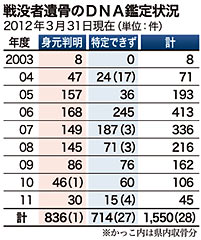
May 31, 2012 Yukiyo Zaha of the Ryukyu Shimpo
On May 30, a spokesperson for the Ministry of Health, Labour and Welfare announced that they had conducted DNA testing on 28 sets of remains of war dead from Okinawa Prefecture (one identified, 27 unidentified). The Ministry has been performing DNA testing on remains of war dead since 2003. In the nine years from 2003 to 2011, a total of 1550 sets of remains (836 identified, 714 unidentified) have been appraised. Bereaved families and a group for the recovery of remains state that DNA testing is not well known by many people and suggest that the government should provide more information. They requested that it be publicized that there is an increasing possibility of identifying remains through DNA testing, and that a thorough survey of remains be carried out.
Because the members of bereaved families are aging, DNA testing becomes difficult for them to get a match to remains. Gamafuya, a volunteer group dedicated to the recovery of remains of the Battle of Okinawa, petitioned 41 municipal councils in Okinawa Prefecture to request to the central government to carry out DNA testing of remains from the Battle of Okinawa. So far 15 municipal councils have passed the petition.
According to information from the Ministry, 636 sets of remains were recovered in Okinawa in the five-year period from 2007 to 2011, which equates to approximately 100 sets being recovered every year. To date, only one set of remains, which was identified in February 2011 using a DNA test to be a man from Chiba Prefecture, has been returned to the bereaved family. When they discovered a fountain pen with his name engraved on it, the volunteer group appealed for information on the man’s family and the remains were then identified using DNA extracted from the man’s teeth.
The Ministry explained a small number of surveys were conducted in the prefecture because it is difficult to extract DNA because DNA easily breaks down in hot and humid area. The Ministry stated that all other pieces of property left behind are also important to identify remains.
Of 836 sets of identified remains, 831 sets were those of detainees in Siberia recovered in the cold and dry former Soviet Union area. Based on a list of burial sites and other returned remains, the Ministry sent an announcement for DNA testing to approximately 8,500 bereaved families.
The person in charge explained, “If the conditions are right for DNA extraction from remains, and there are other items remaining and records, we contact the bereaved family.”
The president of the Gamafuya volunteer group, Takamatsu Gushiken, is critical of the passive stance of the government, saying, “It is the government’s responsibility to at least publicly announce when remains are recovered.” He states, “It is possible to identify remains through DNA testing, but time is not on our side because of the advanced age of bereaved families. I request that a register of DNA be created of bereaved families who wish to be involved, and match those results against those of any remains recovered.” He asked the government to actively promote DNA testing of remains and bereaved families in Okinawa.
(English translation by T&CT, Megumi Chibana and Mark Ealey)
Go to Japanese
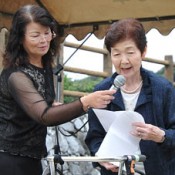
May 27, 2012 Kyoko Ishii of Ryukyu Shimpo
On May 26, at the Rural Environment Improvement Center of Kijoka, Ogimi, the unveiling ceremony was held of a tanka inscription dedicated to Major Hiroshi Terauchi, a Kamikaze pilot who died during the battle of Okinawa. Tokyo resident 86 year-old Ayako Asano, younger sister of the fallen pilot, wrote the tanka to express her gratitude for the local people’s dedication. Twenty year-old Terauchi was killed in aerial combat with U.S. forces off the coast of Kijoka on April 6, 1945, and local people buried his body after it was washed up on the coast of Kijoka the next day.
Her voice tinged with emotion, Asano said, “My brother was able to buried thanks to the kindness of the local people. This was rare among the many kamikaze pilots killed during the war.”
In the midst of fierce fire from the U.S. forces the local people, including Tonzou Kamiyama, who was a member of a civil defense unit, recovered the body of the young pilot. Misako Oyama the head of Kijoka district said, “We heard that local people recovered soldiers’ bodies regardless of whether they were American or Japanese because they too had parents, brothers and sisters in their countries.”
In 1950, the Veterans Administration returned Terauchi’s remains to his family. A personal relationship between Asano and the villagers started from there.
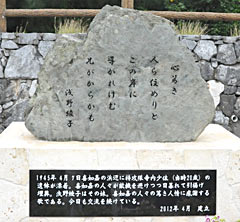
The tanka inscription that Ayako Asano wrote as a requiem to her late brother and to express her gratitude to the residents of Kijoka.
Asano has been to Okinawa many times since she first visited Kijoka in 1967. In recent years, the number of people who know of the incident during the war has dwindled, but Asano has continued to keep in touch with local residents. Zenko Yamashiro, a writer, and Shintaku Yamada, a former principal of the Kijoka Elementary School had the idea of erecting a
tanka inscription of a poem by Asano, but have both have passed away, so the younger generation in the district undertook to realize this for them. Asano has also visited former battlefields in Okinawa many times and has entered into a more profound relationship with the prefecture and its people.
She said, “Just when the war was on their doorstep, the villagers kindly buried the body of my brother without regard to personal risk.
I have never forgotten about Okinawa where such a tough situation has continued since the war. This might be the last opportunity that I have to meet with them, because maybe we getting too old to meet up again. But I was very moved to see the monument.”
At the unveiling ceremony, Asano’s nephew Yushi Terauchi said, “I would like to tell the people of the main islands of Japan about the ongoing hardships of the people of Okinawa. I do not have the words to express my gratitude to all you.” After the ceremony, he looked back, saying, ” While it was a national policy, it must have been very hard for my uncle when he made up his mind to do what he did to defend the country at the age of 20.”
About 20 residents, including 90 year-old Matsu Fukuchi, performed the usu-deku of Kijoka at the ceremony. When you read the lines of the tanka inscription set up near the coast you can hear the tranquil sound of the waves. It says: “Led by the Gods, my brother came down to rest in peace on a beach where warm-hearted people live.”
(English translation by T&CT, Mark Ealey)
Go to Japanese
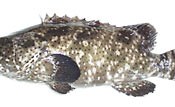
June 3, 2012 Maki Nagamine of Ryuyku Shimpo
Cultivation of estuary cod (mibai in the Okinawan dialect), a fish well known for its high-grade white flesh, has been steadily increasing. The production volume for fiscal 2010 exceeded 80 tons, the highest level to date, and the return on production has exceeded 100 million yen for the first time. The Okinawa Prefectural Government (OPG) is striving to increase the scale of the market outside Okinawa by developing techniques to transport live fish without using water. Targeting overseas countries that consume large quantities of estuary cod, the OPG intends to increase the production volume further in future.
When the cultivation of estuary cod began in fiscal 1997, the production volume was five tons, and the returns on production amounted to eight million yen. In fiscal 2000, as the number of producers increased, the production volume rapidly went up to 53 tons and the value of returns on production to 86 million yen.
While the production volume has been moving between 50 to 70 tons in recent years, the production volume soared to 88 tons and the production value to 120 million yen in fiscal 2010, both record highs. A representative of the OPG said, “We expect the production volume to exceed 90 tons this fiscal year.”
In 2010, the OPG developed a technique to keep cultivated estuary cod alive without water for about eight hours by soaking them in saltwater and inducing a state of suspended animation, making it possible to transport the fish alive. In fiscal 2011, the OPG budgeted 20 million yen to promote the market for transporting live estuary cod without water. The goal is to create employment for private distribution companies and to help expand markets outside of Okinawa.
The Kawaman Store Company of Urasoe, which was entrusted with the project, employed four people, and has promoted various events. In the 13th Japan International Seafood & Technology Expo held at Tokyo Big Sight last July, the company ran a booth introducing estuary cod. In October the same year at the Tsukiji Fish Market, otherwise known as the Tokyo Central Wholesale Market, the company invited 150 fish distributors and people involved in the catering industry to a tasting party in which they introduced estuary cod.
Kawaman president Kiyotaka Kawamitsu said, “I want to expand the market to Hong Kong where people eat estuary cod. The ones produced in Okinawa have a less fishy odor with better flesh compared with those produced in other countries. I would like to set the price relatively high and target upper to middle class customers.” While the shipping volume of estuary cod amounted to about ten tons in Okinawa in fiscal 2011, this year the company aims to ship about 16 tons outside Okinawa and about 23 tons overseas.
This fiscal year, the OPG intends to continue the project, for which it has budgeted about 10 million yen, and also to encourage private companies to expand the market overseas. Kazuhiko Shimada, the head of the Agriculture, Forestry and Fisheries Planning Division of the OPG, said, “There are still issues to resolve regarding the flesh of the estuary cod, and as we fix these step by step, we want to expand the production of estuary cod.”
(English translation by T&CT, Mark Ealey)
Go to Japanese
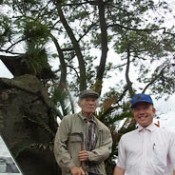
May 29, 2012 Ikue Nakaima of the Ryukyu Shimpo
In Kagoshima City, there are four Okinawa pines (Pinus luchuensis) growing beside a road with a view of Sakurajima. Kagoshima resident Shoji Yoshimi, who has looked after these pine trees for 40 years, decided to hand on the baton to his son Akira on the occasion of the 40th year of the reversion of Okinawa to Japanese sovereignty. The Yoshimi family has lived in Okinawa and the pine trees remind them of their time in the prefecture.
The Okinawa pines are located in a place called the Ryukyuan’s Pine in a corner of the Iso Way in Yoshino, Kagoshima City. Pine trees have been there since the time of the Satsuma domain. There is a theory the name of the place originates from the fact that Ryukyuan ships visiting Satsuma used a pine tree as a landmark.
In commemoration of the anniversary of the reversion of Okinawa to Japanese sovereignty, in 1973 Naha City presented six Okinawan pines to Kagoshima City and planted them on this site. Shoji, from Tokunoshima Island, managed a gas station in Okinawa from 1953 to 1972, before moving to Kagoshima in 1973. When he heard that there were Okinawa pines in the city, he went to the Ryukyuan’s Pine but found that the pines were about one meter (3.3 feet) tall had been left unattended, surrounded by weeds.
There is no source of water near where the pines are, so through the years Shoji carried water from his home by car every time he went to pull up weeds. To date, two of the pines have died from drought and pine wilt disease, but the remaining four are healthy.
Shoji runs a real-estate business based in Kagoshima, but has expanded it throughout Japan. “I was moved by the kindness of the Okinawan people and how they readily help others carry their baggage. The approach to interacting with others that I learned in Okinawa helped me create a successful business.” He kept taking care of the pines as a way of doing something for Okinawa. He said that it is not that he raised the Okinawa pines but that they have helped him grow. He decided to pass the baton on to his son when he reached the age of 80 and started to experience failing health.
Akira lived in Okinawa until he was in the first year of junior high school and has not been back for about 20 years. But whenever he sees his old school, Futenma Second Elementary School, which is right next to Futenma Air Station, on the television news, he can’t believe how people could study in such a horrible place, and he worries about Okinawan people living alongside bases. “When I see the pine trees, I always think of Okinawa. I really want to protect and look after them carefully,” he said, looking up the pines that are now over five meters (16.4 feet) tall.
(English translation by T&CT, Lima Tokumori and Mark Ealey)
Go to Japanese
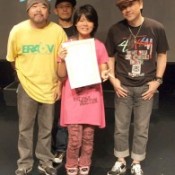
June 3, 2012 Ryukyu Shimpo
In the afternoon of June 2, at Music Town Oto Ichiba in Okinawa City, the final audition was held for bands performing at the 30th Peaceful Love Rock Festival and a 13 year-old girl from Okinawa City, Sakura Ishado was selected. She will be the youngest performer in the history of the festival. “I have dreamed of performing in the festival since I was child. I am so glad. I will work hard practicing my singing and drumming.”
When she was five years old, she saw the festival and dreamed of appearing on stage. She began practicing the drums after entering elementary school and during the last six years has performed at several events and clubs offering live music. This April she released a CD.
At the open audition, Ishado gave a stirring performance of a song she wrote herself. Her powerful singing and drumming won the hearts of the judges and the audience. In addition to Ishado, a band called “The Laughing Moon” whose members are based mostly in Ginowan, was also selected to take part in the festival.
Great Gidayu, an entertainer and musician who will support Ishado with her arrangements, was pleased with the decision, saying, “Her performance was just amazing. Her singing resonates with people because she’s singing about the feelings of a 13 year-old girl, and that’s just what she is.”
(English translation by T&CT, Lima Tokumori and Mark Ealey)
Go to Japanese
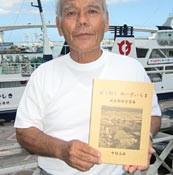
June 3, Hideaki Yoneda, correspondent of the Ryukyu Shimpo
Fumio Nakamura, who currently lives on Maejima Island, which comes under the administrative authority of Tokashiki Island and is located about 25 kilometers west of Naha, published a book entitled Hand on to the Next Generation – Megirama, about the history and lives of people on Maejima, his home island. Nakamura is the head of the residents’ association for restoring Maejima. The book includes information on events, local flora and fauna, folk stories and details of place names, a map and shop names, as well as the genealogy of Maejima.
The book is printed in B5 format (182mm x 257mm) and is 128 pages.
Nakamura thought that he did not want the island’s long history, which his ancestors helped shape, to be lost. He wrote it based on interviews with elders from the island carried out in a period spanning more than 25 years while he was working.
Nakamura said, “I will be happy if the people of Maejima and their descendants are able to use this book as a document passed down through the generations because there are few records available on the history of Maejima Island.”
After the war, more than 100 people including demobilized soldiers and returnees to the island from places overseas including South Pacific Islands added to the number of residents on Maejima. The population of the island expanded to 380, but then damage to houses caused by a string of powerful typhoons caused hardships such as food shortages, forcing the people to leave the island one after the other. The last four families went to live in Naha in February 1962 and Maejima Elementary and Secondary Schools were closed. With this the island became uninhabited.
Nakamura was born in Chuuk, an island group in the southwestern part of the Pacific Ocean. He moved back to Maejima, where his father is from, at the age of four, and when he was 14 years old he moved to Naha as part of a group-relocation.
Because Nakamura could not let go of the memories of his home island, to which he still felt very attached, he and his wife relocated to Maejima in 2003 after he retired to help restore the island, which by then had in effect become uninhabited. With this, Maejima became inhabited for the first time in 42 years and became the 40th inhabited island in Okinawa Prefecture. Four people have now registered their residency on Maejima – Nakamura, his wife and son, and a friend.
The book sells for 1000 yen. For further details, call Nakamura at 098 (8290) 6361.
(English translation by T&CT, Mark Ealey)
Go to Japanese
June 3, 2012 Ryukyu Shimpo
The U.S. Government has sent the Ministry of Defense an unofficial report stating that human error caused the MV-22 Osprey vertical take-off and landing transport aircraft crash in Morocco in April, and that no mechanical problems have been found. This was revealed on June 2. The U.S. government does not plan to change the schedule for the Osprey deployment to Futenma Air Station, and will transport them to Naha Military Port in July.
The U.S. government will officially convey their findings on the accident to the Japanese government within the next few days, and after receiving the report, Ministry of Defense will explain it to the Okinawa Prefectural Office. Some experts suggest that the crash was caused by human error, but have indicated that there is an issue with the structural mechanism that controls this, causing more anxiety about inherent risk. Experts pointed out that not enough had been done on the investigation of the crash because by rights it should take at least six months to carry it out. They speculated that the hasty investigation report is in order to expedite the Osprey deployment to Okinawa in July.
The governments of Japan and the United States will proceed with the planned deployment of the Osprey to Okinawa on the grounds that no structural failures for the aircraft have been reported. On April 11, in Morocco, a MV-22 crashed during military exercises, killing and injuring four Marines.
On the subject of the accident, Okinawa Governor Hirokazu Nakaima opposed the deployment to Futenma Air Station, saying, “It is difficult to accept them into Okinawa.” In a telephone conversation, Defense Minister Naoki Tanaka asked Secretary of Defense Panetta to provide information about the crash.
When he met Parliamentary Secretary Hideo Jinpu, who visited the United States in late May, Acting Under Secretary of Defense for Policy James N. Miller said that the U.S. government will provide the details of the accident analysis report as soon as it is ready. Subsequent to this, the Japanese government received an unofficial report from the Pentagon to the effect that the cause of the accident is human error, but the Pentagon has not disclosed the details of that human error. A senior official of the Ministry of Defense commented that if were a flaw in the aircraft, it would have stopped flying, and speculated that the accident had therefore was clearly caused by human error.
Ministry of Defense officials said that they would like to report the cause of the crash in Morocco to the Okinawa Prefectural Government before they discuss how and when to deploy the Osprey to Okinawa.
(English translation by T&CT, Mark Ealey)
Go to Japanese
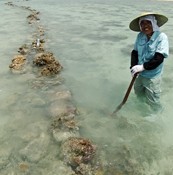
May 26, 2012 Ryukyu Shimpo
On Kohama Island in Taketomi, 77 year-old Kenji Miyazato is working to revive a traditional fishing method called kasuku.
Miyazato said, “It will be a natural aquarium. I think that it could help children learn about the ocean.”
Kasuku is a fishing method that utilizes the tide. A stonewall was built in shallow water, and at low tide people would catch the fish trapped inside. About 30 kasuku have been identified around Kohama Island, but the stonewalls have fallen apart and none are still in use.
Instead of using rocky coral, a type of curved blockish stone called kubiri ishi was used in the walls. It is not known where the stone came from.
Miyazato owns a 500-meter long kasuku that was made by his ancestors. He makes use of the low tide to pile up stones one by one.
In the afternoon of May 21, he was at work repairing the stonewall by hand during the spring tide. He hopes that it will be complete by the end of the month.
(English translation by T&CT, Shinako Oyakawa and Mark Ealey)
Go to Japanese
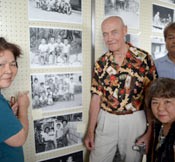
May 25, 2012 Ryukyu Shimpo
A photo exhibition entitled “Mayaga, Tayaga, Nuyaga (Where is it, Who is it, What is it) @ Kitanakagusuku” was held in a local community center through until May 15. Former marine Dick Bruce, now 73 year-old and living in Washington DC, displayed 200 photographs that he took between 1958 and 1959 in Uruma near Camp Courtney. Some visitors actually found themselves in the pictures and commented that the photographs represent a precious record because hardly anyone owned cameras back in those days.
Bruce was stationed in Okinawa from 1958 to 1959 as a member of a U.S. Marine band, and 53 years later he visited Okinawa to donate his old photos to the local society. It was not possible to identify most of the people and the places that appear, but some of them were thanks to cooperation of visitor to the exhibition. Bruce said, “I received kind words from many of the visitors. They were just as warm as when I was here 53 years ago.”
Sixty-two year-old Eiichi Yokota found an old photograph of himself in the exhibition. Bruce and eight boys were in the picture with gloves and a crumpled paper ball. Yokota said, “It makes me feel like a child again. I was always out there playing baseball in bare feet.”
Sixty year-old Yoshimitsu Goya also found himself, aged eight, in one of the pictures. He said, “It reminds me of the tough times I went through back then.”
(English translation by T&CT, Shinako Oyakawa and Mark Ealey)
Go to Japanese
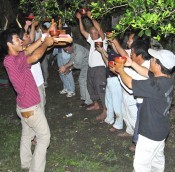
June 1, 2012 Ryukyu Shimpo
From May 31 to June 2, the harvest festival Sutsuupunaka was held at four sites in Tarama, with all the villagers hoping for a year with a good harvest and prosperity.
Based on their respective roles, groups called za are formed for each of four ceremony sites of Nagashiga, Fudaya, Piejuni and Areeki. The busha-za group makes and serves libation called misu, and the kuban-za group cooks the food. On May 31, the villagers worked hard all around the village to prepare for the festival.
From late in the evening on May 31 into the early hours of June 1, villagers conducted akatsukinigai, in which male villagers sang sacred songs called niiri at each of the ceremony sites and passed around libation in square plates and saucers, singing as they hoped for a year with a good harvest. Divine songs echoed around the dim and quiet village.
On June 1, tsukasanma, or women who administer the ritual, and invited guests visited the ceremony sites one after the other.
Along with the Hachi-gatsu odori (August Dance), which is designated as an intangible folk cultural asset of the village, Sutsuupunaka is one of Tarama Village’s traditional feature events.
(English translation by T&CT, Mark Ealey)
Go to Japanese
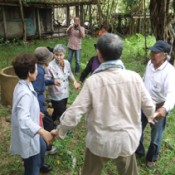
May 26, 2012 Ryukyu Shimpo
On May 20, people born on Shimoji Island, which is administered as part of Taketomi and has been deserted since 1962, chartered a dive boat to visit the island with their families on the occasion of the fiftieth anniversary of their departure. In spite of bad weather, about 20 participants went on an emotional trip to see the ruins of houses, the site of the school that they used to attend, and an unchanged well. Some of the people were returning for the first time since the village had been abandoned. At the end of the homecoming, all the participants recalled aspects of their past when they sang and danced the traditional performing arts of the island.
The postwar relocation of the Yaeyama Gunto Government to Iriomote Island and Ishigaki Island caused the population of Shimoji Island to decline. The junior high school section of the Ohara Elementary and Junior High School on the island was closed in 1953, and the elementary school subsequently closed in 1954.
Even after the schools were closed some elderly people continued living on the island, but they left the island together after the last harvest festival in 1962.
Nobunaga Arakawa, who was among the last elementary school pupils on the island, said, “I moved to Iriomote Island. On fine days, I could see the island, and that did make me feel homesick. To be honest, I thought that I would never come here again, but I’m very glad to have been able to return.” He was at a loss for words when he saw the desolate land, but at the end of the visit he managed a smile as he performed a traditional dance.
Yukio Otake, who moved to Ishigaki Island when he was just five years old, visited his old home for the first time in 68 years, said, “The well in my house is still there, and that made me remember how all the villagers used to gather to make sake.” He said, “I have wanted to return to the island where my parents lived, but it was difficult to charter a boat, so I had been unable to get back. Finally, I could get back, but I couldn’t remember where our house was.”
Akira Maezato, the person who planned this home visiting, smiled saying, “Every year I come back to the island to help clean up, but it is very different, deep feeling to be returning when it comes to the fiftieth year. It is indeed a pleasure to come here with everyone together.” He added, “I have cancer, so I don’t know what will happen for me from now on. But, I do want to visit here again on a fine day next year.”
(English translation by T&CT, Lima Tokumori and Mark Ealey)
Go to Japanese











 Webcam(Kokusai Street)
Webcam(Kokusai Street)


